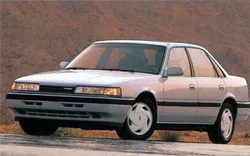

Mazda 626 - Generation 2 - GC Overview
Discover the Mazda 626 generation 2 - GC features and specifications. Explore its performance and design, making it a great choice for car enthusiasts in Portugal.
The Mazda 626, particularly the second generation (GC), represents a pivotal moment in the evolution of mid-size sedans during the 1980s. Produced from 1987 to 1992, this iteration was known for its blend of modern d...
Technical Specifications
Select Version
Dimensions
Engine
Driving
Others
History and Features
Mycarro AI
Apr 27, 2025
The Mazda 626, particularly the second generation (GC), represents a pivotal moment in the evolution of mid-size sedans during the 1980s. Produced from 1987 to 1992, this iteration was known for its blend of modern design, practicality, and reliable performance. As a continuation of Mazda's push into the competitive mid-size market, the GC model introduced new styling cues and technological advancements that appealed to a broad audience.
Design and Aesthetics
The Mazda 626 GC featured a more rounded and aerodynamic design compared to its predecessor. The shift from sharp angles to smooth, flowing lines was a major change in the automotive landscape of the time. The front end boasted a bold grille and an integrated bumper that offered a more modern appearance. The overall silhouette of the car was sleek and sporty, which helped it stand out in a segment crowded with competitors. Its wheelbase was expanded, providing more interior space and stability on the road.
Interior Features
Inside, the second-generation Mazda 626 was well-equipped for its time. The cabin emphasized comfort and usability, marked by supportive seating and high-quality materials that were built to last. Notable features included air conditioning, power windows, and a sophisticated audio system that catered to the needs of everyday drivers and families alike. The thoughtful layout of controls and instrumentation contributed to an overall sense of cohesion and user-friendliness within the vehicle. With ample cargo space available in the trunk, the 626 also afforded good practicality for various lifestyles.
Engine Options
Under the hood, the Mazda 626 GC provided a range of engine options to meet different driving desires. The base engine was a 2.0-liter four-cylinder, delivering a respectable balance between fuel efficiency and power. For those seeking enhanced performance, a more powerful 2.2-liter turbocharged engine option was offered, which appealed to enthusiasts who craved a more spirited driving experience. The emissions standards of the late 1980s were beginning to tighten, so Mazda incorporated innovations to maintain compliance while enhancing vehicle efficiency.
Transmission and Ride Quality
Mazda's engineering team put emphasis on the driving dynamics of the 626 GC. The model came standard with a five-speed manual transmission, with an automatic transmission available as an option. This combination allowed drivers to engage more with the vehicle, whether for everyday commutes or weekend getaways. The suspension setup was designed to balance comfort and sportiness, providing a smooth ride on various road conditions while ensuring nimble handling during spirited driving.
Safety Features
Safety concerns were becoming increasingly prominent during the late '80s, and the Mazda 626 GC offered features designed to protect its occupants. With a strong emphasis on structural integrity, the design included crumple zones and an enhanced safety cage to absorb impact in case of an accident. Such innovations helped position the 626 as a solid option for families, as well as individuals aiming for peace of mind while on the roads. While not as advanced as what is found in today's vehicles, the attention to safety paved the way for future innovations in Mazda's lineup.
Cult Following and Legacy
The Mazda 626 GC developed a loyal following, and its reputation for reliability and practicality helped it carve out a niche amongst used car buyers in later years. It was revered less for being an exhilarating performance vehicle and more as an accessible and dependable choice for everyday use. However, as the automotive market shifted towards SUVs and more luxury-oriented offerings, the 626 began to phase out of the spotlight.
Ultimately, the Mazda 626 Generation 2 (GC) stands as an important piece of automotive history. Its blend of modern design, reliable engineering, and user-focused features set a solid foundation for future generations of Mazda vehicles. While it may not be as well-remembered as some of its contemporaries, the legacy of the 626 GC remains relevant, reflecting a time when mid-sized sedans were celebrated for their balanced approach to performance and practicality.
